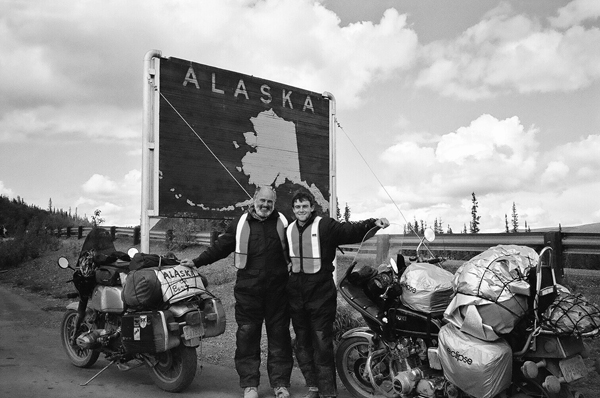We covered so much territory this day that everything we did seemed very far away at day’s end. It did not feel as though I was in a worn and torn lodge overlooking Kluane Lake just that morning. It felt more like several days. I was not unusually tired, and we had certainly pushed back more miles in a day, but the jump from Kluane Lake to Fairbanks in Alaska seemed intuitively too large. Assuming no hallucinations, it did all actually occur though.
The AlCan – the Alaska–Canada Highway’s shorthand name – diversified its interests and expanded into a new market: rolling mini dunes of frost heaves. Bouncing around in the heaviest rain of the trip so far, we experienced every one of the gut-busters that the road threw our way. I wove and meandered through rises and falls, all while trying to minimize how hard my chest’s breath would be jounced and how fast the suspension would bottom out hard, metal against metal.
Many could not be avoided entirely, and sometimes avoiding one just meant slamming another. The frost heaves were not like I had expected. Yet another cut to preconceived ideas. I had thought they would be ruptures in the pavement, with fragmented pavement on top, strewn ahead by passing cars. Instead, they were quick up and down roller coaster rides, smooth but sudden. This made them sometimes difficult to spot from a distance, especially when everything grayed out under a cloud-hidden sun. I learned to read the vertical curves over time, and tell-tale signs were usually on each one: skid marks from the tires of hopping towed trailers. The black patches were very helpful as I would flow the bike into a large dip and simultaneously rise and lower myself above the seat while standing on the foot pegs.
After riding like a pogo stick this way, we finally crossed the imaginary international line into Alaska. It felt really good inside to have made it to that big objective of the trip. It had been a mysterious goal at first, going off to a big rugged state far from the reaches of home and the continental US. Then a weathered sign appeared, and it all became reality.
I immediately noticed how the sunlight seemed brighter on everything from trees to picnic tables to my soda can. And the atmosphere of the land changed quickly, too. The aspens came back in waves, the clouds were stronger, and the distant Alaska Range was younger and more challenging. Nature did not recognize international boundaries, but this was definitely something new.
After passing through the two minute why-even-bother US Customs inspection, the relative quality of Uncle Sam’s roads became quickly apparent as well. For the first time in seemingly years, I was gliding over smooth blacktop with non-gravel shoulders and brightly painted lane lines. What a change: my steering inputs gave intended outputs, unlike a bump combined with wind gust over sliding stones to make creative random outputs.
However, all was not bliss. Motorcycle Hell oozed its way over the international line and took a foothold in an eighteen mile stretch of road. What the gravel lacked in roundness it made up for in squishy depth. And the yellow-white dust storms from passing construction trucks were invigorating, too. And I knew that M. H. would be laying low like a predator: we had to come back that way.
The people of Alaska seemed less laid back than those in Canada, but they were generally as pleasant. A little more hurried and brusque, but not by much. The shops also became specialized again, and they accepted – as Dad jokingly called it – “real money”. I found myself still doing multiplication in my head, converting kilometers on signs to the miles I better understood. I had to remind myself that the conversion had already been done for me. I was creating new units.
After leaving Tok, the road straightened out for mile after mile. The only variety was up and down. Horizontally, it was 2D. Since there were no wind gusts, I simply held steady and became mesmerized. The road stayed mostly on flatlands, but I could see the Alaska Range sliding by over the trees. The Alaska Range was my favorite mountain scenery of the trip so far, with jagged outlines and snow that covered not only their peaks but filled the faces down to their bases.
We gradually approached them at an angle, and touched their foothills briefly before jutting across more flatlands to the North Pole. The North Pole was a real town, and yes they did have a bunch of hokey, touristy gimmicks that capitalized on their namesake’s relationship to Santa Claus.
We then finally made it to the end of the Alaska Highway. It officially ended in Delta Junction. We had originally thought it ended in Fairbanks, and that was originally intended to be our highway finale. The contrary news was a briefly perplexing surprise, but it did not change our plans.
We stayed in Fairbanks at the Ranch Motel. Although I was writing until past 2:00 in the morning, the sky was still light. I thanked the inventor of curtains when I went to bed.

